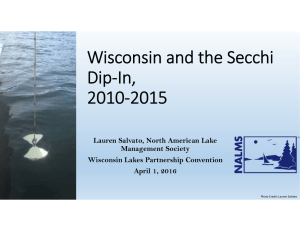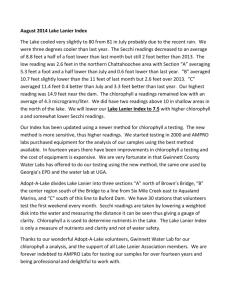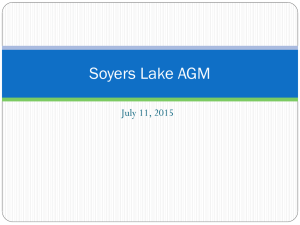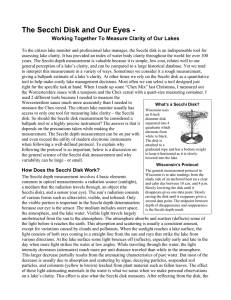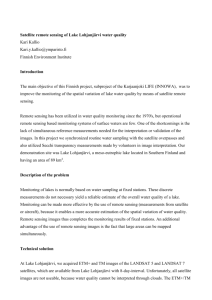B 1. SECCHI MONITORING
advertisement
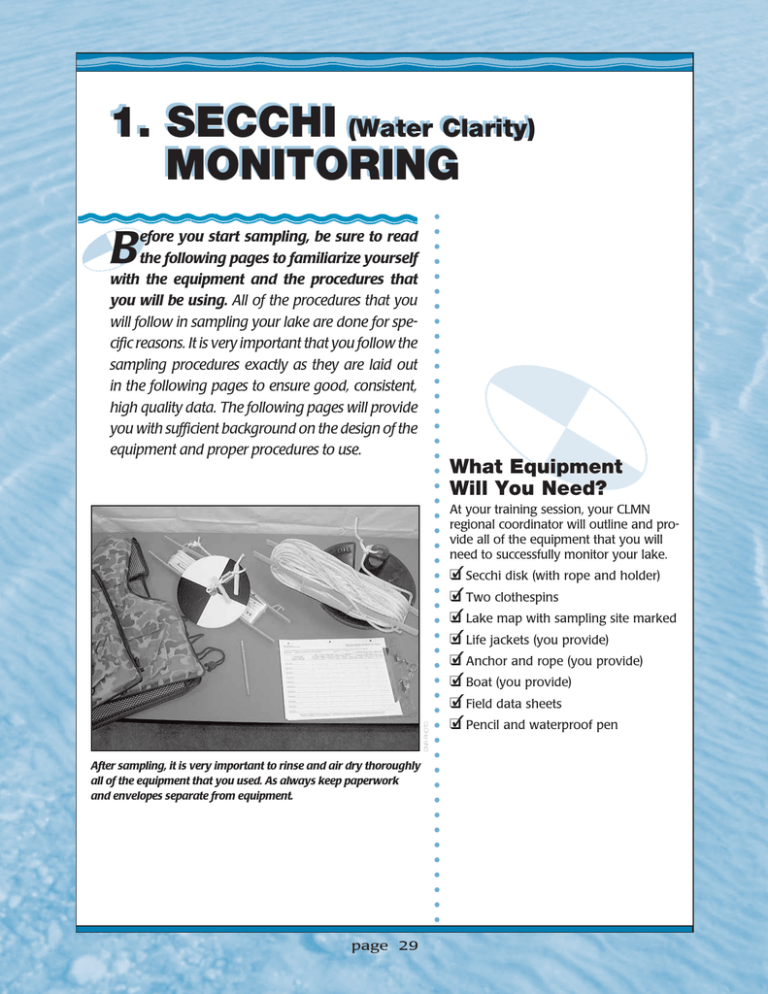
1. SECCHI (Water (Water Clarity) Clarity) MONITORING B efore you start sampling, be sure to read the following pages to familiarize yourself with the equipment and the procedures that you will be using. All of the procedures that you will follow in sampling your lake are done for specific reasons. It is very important that you follow the sampling procedures exactly as they are laid out in the following pages to ensure good, consistent, high quality data. The following pages will provide you with sufficient background on the design of the equipment and proper procedures to use. What Equipment Will You Need? DNR PHOTO At your training session, your CLMN regional coordinator will outline and provide all of the equipment that you will need to successfully monitor your lake. After sampling, it is very important to rinse and air dry thoroughly all of the equipment that you used. As always keep paperwork and envelopes separate from equipment. page 29 3Secchi disk (with rope and holder) q 3Two clothespins q 3Lake map with sampling site marked q 3Life jackets (you provide) q 3Anchor and rope (you provide) q 3Boat (you provide) q 3Field data sheets q 3Pencil and waterproof pen q W I S C O N S I N C I T I Z E N L A K E M O N I T O R I N G T R A I N I N G M A N U A L SHOULD I COLLECT SECCHI DATA IN THE WINTER? How Do You Prepare to Sample? Secchi measurements taken through the ice are highly variable depending on the amount of snow on the ice and ice clarity (i.e. did it freeze fast or was there slush on the lake that froze and created “cloudy” ice). These are the main factors that determine the amount of light that can get through the ice which allows you to take accurate measurements. Since algae production is at a minimum under the ice, this data has no real value for Network use. On the day you plan to sample, complete the top portion of your field data sheet by filling in the waterbody # (or WBIC) “Station # (or storet #),” sections. Enter the name of each volunteer who will be sampling. If you do not know these numbers, contact your CLMN regional coordinator. Before you launch your boat, make sure you have your Secchi disk, an anchor, and personal flotation devices (life jackets) in your boat before proceeding to your sampling site. The Day You Sample Sampling Overview When to Take Your Secchi Readings The weather can affect the depth at which you can no longer see the Secchi disk. Wind-generated waves, sun position, and cloud cover are major weather factors that can affect the accuracy of your readings. • Ideally, Secchi readings should be taken every 10 to 14 days. • Ideally, Secchi readings should be taken on clear, calm days between 10 am and 4 pm. Waterbody # or WBIC (Waterbody Identification Code) • A unique identification number the Wisconsin DNR uses to identify each waterbody in the state. Every one of the 15,000 lakes in Wisconsin has a unique WBIC. Station # (or Storet #) • A number assigned to sampling locations on a waterbody. The station identification number makes it easy to track secchi and chemistry data. Each sampling site on a lake will have a separate station identification number. VOLUNTEER IDENTIFICATION NUMBER All data collected in CLMN is tied back to an individual’s volunteer id number. • Anchor the boat. • Secchi disk readings are taken on the shady side of the boat. • Kneel or sit so you are close to the surface of the water. • Remove your sun glasses – sun glasses can increase the depth that you can see your Secchi disk. For consistency and so we can compare data from one lake to another, please remove your sun glasses. • Use clothespin method to determine accurate reading. • For color and clear/murky determination, hold Secchi disk one foot below the surface of the water. To make sampling regular and convenient, try to make it a part of your weekly routine. You can include it as part of your weekend fishing trip or family outing on the lake. The most important time to collect your Secchi data is in July and August. These are the prime months for lake recreation and the time when algae is the most prevalent. Secchi analysis statewide relies on information for these months and will appear in your statewide summary. Averages of Secchi data recorded during July and August will appear in your statewide summary report. Due to seasonal variation, the entire years’ Secchi disk data cannot be averaged. page 30 The Secchi readings you take in the spring and fall will tell a story about your lake. These readings can tell you when spring runoff occurs in your lake or when there are algal blooms. For this reason, many Secchi volunteers may start collecting data in April and continue through November. But for a variety of reasons other volunteers may choose to start in June and only continue sampling through September. If you are unable to sample during your normally scheduled sampling time, do not worry about it! Just try to sample as soon as possible after that time. However, if you think that you will not be able to continue monitoring your lake due to illness, schedule conflicts, or other problems, please contact your CLMN regional coordinator as soon as you can. Some states collect Secchi readings differently than Wisconsin volunteers do. Some use different sized and colored disks or unmarked ropes. Some monitor on the sunny side of the boat. The most important thing is that Wisconsin CLMN volunteers remain consistent in monitoring protocols so we can continue to compare Wisconsin lakes to one another. In recent years, the WDNR has implemented a satellite water clarity program. This program originated in 1999 as a UW–Madison research project that has now transitioned into a WDNR operational program that estimates water clarity on approximately 8000 lakes annually across Wisconsin. The WDNR depends on citizen-based monitoring (CBM) for field measurements needed in satellite calibration. This powerful management tool that helps the agency monitor a large number of lakes in a cost-effective manner (less than $1 a lake). The large database supplied by this effort can assist managers is looking at the “big picture” with respect to Wisconsin’s changing lake conditions, i.e. how are lakes changing in different regions of the state, different lake classes, different size lakes? In the near future, we hope to start examining how lakes are responding to past and future climatic conditions and landuse changes. We participate in the study from July 1 to September 15. Each lake is assigned a path number. This path number will let you know the dates when the satellite will be overhead. Go out on any of these days you can and sample your lake as you normally would, preferably on clear, calm sunny days. There is no need to let us know that you sampled for the satellite experiment, just report your data as you normally do. For paths and sampling dates please visit http://dnr.wi.gov/lakes/CLMN/. page 31 CAROL WATKINS, UW-EXTENSION, ENVIRONMENTAL RESOURCES CENTER Remote Sensing Project W I S C O N S I N C I T I Z E N L A K E M O N I T O R I N G T R A I N I N G M A N U A L ON LAKE PROCEDURES How to Use the Secchi Disk STEP 1. Before going out to take your Secchi disk readings, be sure the conditions are right for sampling. Ideal weather conditions include sunny or partly sunny/cloudy skies; wind-calm to breezy (there should be no whitecaps on the lake). Collect Secchi measurements between 10 am and 4 pm. If possible, try to collect Secchi readings when the satellite is overhead. STEP 2. Your CLMN regional coordinator will provide you with a lake map with the sampling site marked. Be sure you have a station id number for each site you are monitoring. STEP 3. Anchor your boat at your sampling site to prevent drifting. Be careful not to disturb the sediments on the lake bottom when anchoring since this could cloud the water. Remove your sun glasses. Wearing sun glasses will give you an unnatural reading. Unwind the Secchi disk rope from the holder. STEP 4. Lean over the shady side of the boat and slowly lower the Secchi disk into the water until you can no longer see it. If you are sampling in a pontoon boat, be sure to kneel down on the floor of the boat when you take your readings so you are closer to the surface of the water. Be as close to the surface of the water as you can safely be. Secchi disk readings are taken on the shady side of the boat to reduce glare. STEP 5. When the Secchi disk barely disap- pears from your view, mark the rope at the surface of the water with a clothespin. • Secchi values vary by about 6% due to change in sun’s angle in midsummer. DNR PHOTOS • 5” waves can decrease Secchi reading by 10%. page 32 ON LAKE PROCEDURES How to Use the Secchi Disk (continued) the clothespin, lower the disk a few more feet into the water. Slowly raise the disk. When the Secchi disk reappears, mark the rope at the surface of the water with the second clothespin. The clothespin marks may be at the same spot, several inches or even several feet apart. The purpose of lowering the Secchi disk and raising it back into view is so your eyes become accustomed to looking into the water. The average of the two readings will be a more accurate result. STEP 7. Bring DNR PHOTO STEP 6. After you have marked this spot with the Secchi disk back into the boat. STEP 8. Average your two Secchi disk read- ings by forming a loop between the two clothespins. Slide one clothespin into the center of the loop to mark it. Remove the other clothespin. The remaining clothespin mark will be your Secchi reading. rope is marked in foot increments. The red lines indicate five, fifteen, and twenty-five feet. The double black lines indicate ten, twenty, and thirty feet. Carefully measure the number of feet from the disk until you reach your clothespin mark. Round off to the nearest quarter foot. STEP 10. Record this measurement on your data sheet and then fill out the rest of your data sheet. (continued on next page) page 33 JIM KLOSIEWSKI STEP 9. Your W I S C O N S I N C I T I Z E N L A K E M O N I T O R I N G T R A I N I N G ON LAKE PROCEDURES How to Use the Secchi Disk (continued) STEP 11. Record your perception of water color and water appearance. Hold the Secchi disk one foot under the surface of the water to determine color and appearance. Record perception. This is your perception of the amount of algae that is in the water at the deep hole. Perception Numbers 1­- Beautiful, could not be any nicer. 2­- Very minor aesthetic problems, excellent for swimming and boating. 3­- Swimming and aesthetic enjoyment of lake slightly impaired. 4­- Desire to swim and level of enjoyment of lake substantially reduced because of algae (would not swim, but boating is okay). 5­- Swimming and aesthetic enjoyment of the lake substantially reduced because of algal level. STEP 12. If you are taking Secchi readings at more than one site or lake, proceed to your next location and repeat steps 1 through 10 above (step 11, perception, is recorded at the deep hole only.) STEP 13. Report your data. Data can be submitted electronically at the CLMN web site. Instructions for entering data are in Appendix 2 of this manual. If you enter data online, you do not need to submit data sheets by mail. For those without Internet access – data sheets can be mailed to your CLMN regional coordinator to be entered into the database or mailed to the central office in Madison: Department of Natural Resources, Lakes WT/4 101 S. Webster St. P.O. Box 7921 Madison, WI 53791-9087 page 34 M A N U A L
